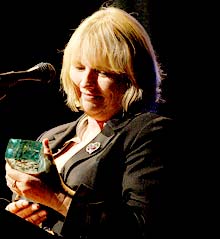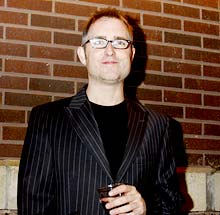The fifth annual Asheville Film Festival is now history—and pretty darn good history it is, too. In so many ways, this was Asheville’s best film festival yet. Things ran smoother, the competition films were of a higher caliber than ever before, and the overall vibe from filmmakers, guests and audiences was just terrific. Everything I went to or looked in on was very well attended.

From a personal perspective, I suspect what I will always remember was standing out front of the Market Place on opening night when the car with Tess Harper and Don Mancini pulled up. Tess—who’d never seen me before—waved, got out of the car, walked up to me and said, “Hi, I’m Tess Harper. Can I have a cigarette?” We kind of became smoking buddies after that. But really, Tess is such a great person that I think we’d have become buddies with or without shared nicotine addictions. She has the happy knack of making you feel like you’ve known her for years in less than five minutes. It helps, of course, that she tells great stories—something that anyone who attended the screenings of her movies knows.
The festival will also be personally memorable because of sharing duties of judging features with Don Mancini (creator of the Child’s Play franchise) and Robby Benson (the actor-writer-director who, by his admission, is best known as the loyal, loving, devoted husband of Karla DeVito). I’ve known Don for a few years now, so I had a pretty good handle on his tastes—which are generally fairly close to mine—but I’d only met Robby in passing during the 2005 festival.
Don and I were both worried that Robby wouldn’t share the passion of a couple horror-heads for Alex Orr’s Blood Car, but he did. In fact, we were all decided on the three candidates for best film. It was just a question of whether the winner should be Blood Car, Ray McKinnon’s Randy and the Mob or David Kaplan’s Year of the Fish. The problem was compounded by the incredible apples-and-oranges nature of the three movies. If you’ve had the chance to see all three, you know that you’d have to try very hard to find three more dissimilar works. There were moments in the decision-making process that found me on the phone with Don in Los Angeles and Don on the computer with Robby in New York as we batted this around. It was so much easier the first year of the festival when there was simply no question of what the best film was. But really, it was a lot more gratifying to find ourselves in the presence of a number of worthy contenders. That, after all, is what a film festival is all about—and what makes it clear that the Asheville Film Festival is more than on the right track.

Another vast improvement over last year were the opening and closing night films. After last year’s dismal duo, it was sheer delight to encounter Tamara Jenkins’ The Savages and Julian Schnabel’s The Diving Bell and the Butterfly. The first was a comedy-drama about a brother and sister (Philip Seymour Hoffman and Laura Linney) faced with taking care of an aging, sickly father (Philip Bosco). Perfect? Maybe not, but it had a very good blend of the comic and the tragic that was far more effective than had it stuck too closely to one tone. The comedy only made the tragedy that much more poignant. (I have it on the authority of my co-critic, Justin Souther, who was sitting next to her, that it made Tess Harper cry at several points.)
The Diving Bell and the Butterfly—which snagged the Best Director for Julian Schnabel at Cannes—was a somewhat different proposition. The telling of the fact-based story of Elle magazine editor Jean-Dominique Bauby, who suffered a stroke that left him with the use of only one eye with which he learned to communicate by blinking, could have been either utterly depressing or overbearingly uplifting. Schnabel—with the aid of fine performances by Mathieu Almaric, Emmanuelle Seigner and Max von Sydow—happily found both humor and believable uplift in the grim story, making the experience a fine capper for the festival screenings.
All in all, the films this year offered such an array of choices that it was easily the most well-rounded festival we’ve ever had. There was everything from the fairy-tale wonder of Year of the Fish, to the quirky comedy of Randy and the Mob and the subversive satirical horrors of Blood Car, to family fare like Simple Things, to splatstick horrors like Murder Party and art-house fare like the experimental Picture of Dorian Gray. A more aggressive approach to obtaining quality entries—along with the growing prestige of being screened at the festival—paid off in golden dividends for the festival and for audiences.
So does all this mean that the Asheville Film Festival is now perfect? Oh, certainly not. There are still things that need attention, things that need fine tuning and things that need expanding, but when all is said and done, 2007 can be viewed as the year the festival came of age. And who knows just exactly what 2008 will hold?



Before you comment
The comments section is here to provide a platform for civil dialogue on the issues we face together as a local community. Xpress is committed to offering this platform for all voices, but when the tone of the discussion gets nasty or strays off topic, we believe many people choose not to participate. Xpress editors are determined to moderate comments to ensure a constructive interchange is maintained. All comments judged not to be in keeping with the spirit of civil discourse will be removed and repeat violators will be banned. See here for our terms of service. Thank you for being part of this effort to promote respectful discussion.